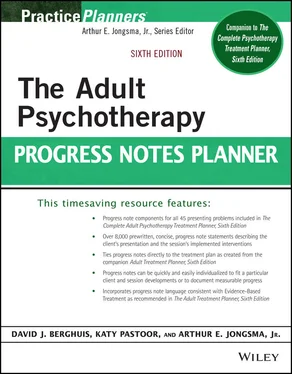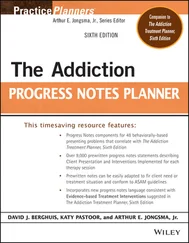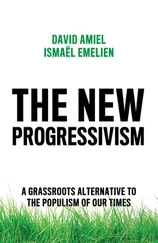21 Develop Insight into Worry as Avoidance (21)The client was assisted in gaining insight into how worry is a form of avoidance of a feared problem and how it creates chronic tension.The client was reinforced for his/her/their insightful understanding about how his/her/their worry creates avoidance and tension.The client struggled to understand the nature of worry as a form of avoidance and was provided with remedial information in this area.
22 Identify Distorted Thoughts (22)The client was assisted in identifying the distorted schemas and related automatic thoughts that mediate anxiety responses.The client was assisted in challenging and changing biases.The client was reinforced as he/she/they verbalized an understanding of the cognitive beliefs and messages that mediate his/her/their anxiety responses.The client was assisted in replacing distorted messages with positive, realistic cognitions.The client failed to identify his/her/their distorted thoughts and cognitions and was gently offered examples in this area.
23 Assign Exercises on Self-Talk (23)The client was assigned homework exercises in which he/she/they identify fearful self-talk and create reality-based alternatives.The client was assigned the homework exercise “Negative Thoughts Trigger Negative Feelings” from the Adult Psychotherapy Homework Planner (Jongsma).The client's replacement of fearful self-talk with reality-based alternatives was critiqued.The client was reinforced for his/her/their successes at replacing fearful self-talk with reality-based alternatives.The client was provided with corrective feedback for his/her/their failures to replace fearful self-talk with reality-based alternatives.The client has not completed his/her/their assigned homework regarding fearful self-talk and was redirected to do so.
24 Construct Anxiety Stimuli Hierarchy (24)The client was assisted in constructing a hierarchy of anxiety-producing situations associated with two or three spheres of worry.It was difficult for the client to develop a hierarchy of stimulus situations, as the causes of his/her/their anxiety remain quite vague; he/she/they were assisted in completing the hierarchy.The client was successful at creating a focused hierarchy of specific stimulus situations that provoke anxiety in a gradually increasing manner; this hierarchy was reviewed.
25 Select Initial Exposures (25)Initial exposures were selected from the hierarchy of anxiety-producing situations, with a bias toward likelihood of being successful.A plan was developed with the client for managing the symptoms that may occur during the initial exposure.The client was assisted in rehearsing the plan for managing the exposure-related symptoms within his/her/their imagination.Positive feedback was provided for the client's helpful use of symptom management techniques.The client was redirected for ways to improve his/her/their symptom management techniques.
26 Assign Imagination Exercises (26)The client was asked to vividly imagine worst-case consequences of worries, holding them in mind until the anxiety associated with them weakens.The client was asked to imagine consequences of his/her/their worries as described in Mastery of Your Anxiety and Worry—Therapist Guide (Craske, Barlow, and O'Leary).The client was supported as he/she/they have maintained a focus on the worst-case consequences of his/her/their worry until the anxiety weakened.The client was assisted in generating reality-based alternatives to the worst-case scenarios, and these were processed within the session.
27 Conduct Exposure In Vivo (27)The client was assisted in engaging in activities usually avoided due to unrealistic worry.The client was assisted in removing any unnecessary, anxiety-driven safety behaviors as described in Mastery of Your Anxiety and Worry—Therapist Guide (Craske, Barlow, and O'Leary).The client was supported as he/she/they engaged in difficulty activities until his/her/their anxiety weakened.
28 Assign Homework on Situational Exposures (28)The client was assigned homework exercises to perform worry exposures and record his/her/their experience.The client was assigned situational exposures homework from Mastery of Your Anxiety and Worry—Client Guide (Zinbarg, Craske, Barlow, and O'Leary).The client was assigned situational exposures homework from Generalized Anxiety Disorder (Brown, O'Leary, and Barlow).The client's use of worry exposure techniques was reviewed and reinforced.The client has struggled in his/her/their implementation of worry exposure techniques and was provided with corrective feedback.The client has not attempted to use the worry exposure techniques and was redirected to do so.
29 Teach Problem-Solving Strategies (29)The client was taught a specific problem-solving strategy.The client was taught problem-solving strategies including specifically defining a problem, generating options for addressing it, implementing a plan, evaluating options, and reevaluating and refining the plan.The client was assigned the homework exercise “Applying Problem Solving to Inter- personal Conflict” from the Adult Psychotherapy Homework Planner (Jongsma).The client was provided feedback on his/her/their use of the problem-solving strategies.
30 Assign Problem-Solving Exercise (30)The client was assigned a homework exercise in which he/she/they problem-solve a current problem.The client was assigned to solve a problem as described in Mastery of Your Anxiety and Worry: Workbook (Craske and Barlow).The client was provided with feedback about his/her/their use of the problem-solving assignment.
31 Engage in Behavioral Activation (31)The client was engaged in “behavioral activation” by scheduling activities that have a high likelihood for pleasure and mastery.The client was directed to complete tasks from the “Identify and Schedule Pleasant Events” assignment from the Adult Psychotherapy Homework Planner (Jongsma).Rehearsal, role-playing, role-reversal, and other techniques were used to engage the client in behavioral activation.The client was reinforced for his/her/their success in scheduling activities that have a high likelihood for pleasure and mastery.The client has not engaged in pleasurable activities and was redirected to do so.
32 Develop Interpersonal Skills and Relationships (32)As interpersonal deficits were identified as a primary factor in the client's anxiety, he/she/they were assisted in developing new interpersonal skills and relationships.The client displayed a clear understanding of the new interpersonal skills and relationships and was reinforced for this success.The client has struggled in regard to developing new interpersonal skills and relation- ships and was redirected in this area.
33 Assign Homework on Communication Skills (33)The client was assigned a homework exercise in which he/she/they implement communication skills and training into his/her/their everyday life.The client was assigned the homework exercise “Restoring Socialization Comfort” from the Adult Psychotherapy Homework Planner (Jongsma).The client's use of homework exercises in his/her/their daily life was reviewed, with reinforcement for success and corrective feedback toward improvement.
34 Provide Psychoeducation About Acceptance Approach (34)The client was taught about acceptance of worry.The client was taught about approaches such as mindfulness, cue detection, monitoring, and decentering.The client was assigned reading from An Acceptance-based Behavioral Therapy for Generalized Anxiety Disorder (Roemer and Orsillo).The client was given supplemental material from The Mindful Way Through Anxiety (Orsillo and Roemer).The client has read the assigned information on acceptance and key points were reviewed.The client has not read the assigned information and was redirected to do so.
35 Differentiate Between Lapse and Relapse (35)A discussion was held with the client regarding the distinction between a lapse and a relapse.A lapse was associated with an initial and reversible return of symptoms, fear, or urges to avoid.A relapse was associated with the decision to return to fearful and avoidant patterns.The client was provided with support and encouragement as he/she/they displayed an understanding of the difference between a lapse and a relapse.The client struggled to understand the difference between a lapse and a relapse and was provided with remedial feedback in this area.
Читать дальше












